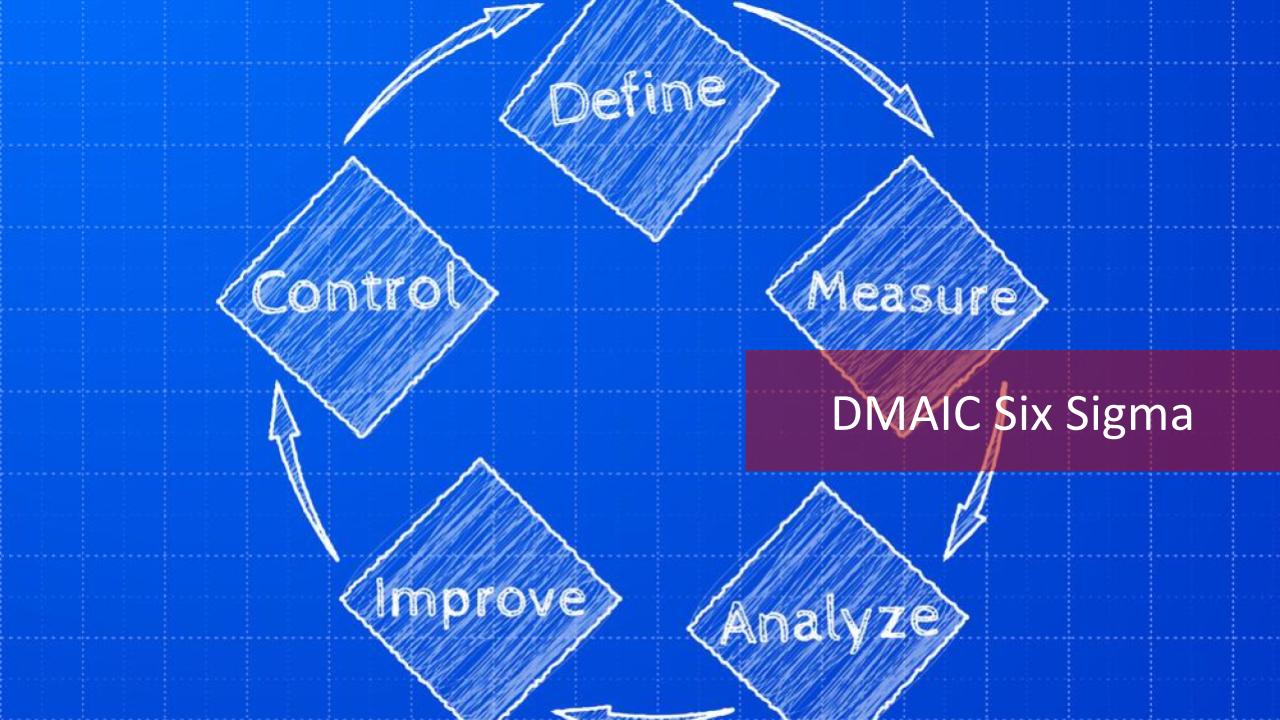Six Sigma is a problem-solving process that is used by engineers and other professionals worldwide. The Six Sigma process is a structured, data-driven approach to problem-solving. There are many aspects to the 6 Sigma ranging in difficulty which is why there are levels of Six Sigma Certification: green belts, black belts, and master black belts. Becoming a Six Sigma practitioner requires completing a Lean Six Sigma Green Belt training. There are also free Lean Six Sigma courses which explain the main process that is our topic for the day: DMAIC.
Attend our 100% Online & Self-Paced Free Six Sigma Training.
The process for Six Sigma is abbreviated as “DMAIC” and each letter in this abbreviation corresponds to a phase. The phases associated with each letter of the acronym is listed below.
- D = Define
- M = Measure
- A = Analyze
- I = Improve
- C = Control
The advantage of the DMAIC as the Six Sigma approach is not the top-level phases themselves but what is contained in each phase. The contents provide a common and structured approach to solving a problem. For each phase, there are some primary activities. Let’s take a closer look at what is DMAIC.
DMAIC: Define
The first phase of DMAIC is Define. This phase of DMAIC aims to define the problem statement and plan the improvement initiative. To define a problem you need a burning platform that illustrates the financial impact if the problem is not solved. This phase is all about defining the problem and the goals of the improvement activity. The most important goals are obtained from the customer. It is critical to understand the Voice of the Customer in order to understand what aspects of the process need to be solved. The description of the problem should include the pain felt by the customer and/or business as well as how long the issue has existed. The goal should be SMART or specific, measurable, attainable, realistic and timely. The Define phase is also the stage where the scope of the project is defined. Scope creep is a big problem. One starts with trying to solve a small problem and the next thing you see you have to solve a massive problem. It is better to define the scope of the problem so that you can identify situations where you are trying to solve a problem that is out of scope. In this phase of DMAIC, the team answers the question “What is important to the business?”

DMAIC: Measure
The second phase of DMAIC is Measure. This phase aims to collect data from the process and understand current quality level. The team measures the existing system in this stage by establishing valid and reliable metrics to help monitor progress towards the goal defined in the previous step. In other words, the team identifies what data is available and from what source. It is important that the measurements are accurate, so it helps to do a test stage during which different operators collect data. In this way, it is possible to determine how the data should be collected to get the most reliable results. Unreliable data collection defeats the purpose of Six Sigma as it is a data-driven approach. They develop a plan to gather it, do the actual data collection and summarize it. In this phase of DMAIC, the team answers the question “How are we doing with the current process?”

DMAIC: Analyze
The third phase is of DMAIC is Analyze. This phase of DMAIC aims to study the business process and the data generated to understand the root causes of the problem. In this phase, the team analyzes the process to identify ways to eliminate the gap between the current performance and the desired goal. The team uses statistical data analysis techniques to arrive at validated root causes of the problem. Solid knowledge of the necessary statistical analysis tools is necessary to get value out of this stage of the process. In this phase of DMAIC, the team answers the question “What is wrong with the current process?”
DMAIC: Improve
The fourth phase of DMAIC is Improve. This phase of DMIAC aims to identify possible improvement actions, prioritize them, test the improvements, and finalize the improvement action plan. This phase is all about proposing and selecting a solution to improve the system. This is the stage where the team has to become creative enough in finding new ways to do things better, cheaper, or faster. Based on the identified root causes, the team directly addresses the causes with an improvement. In this phase of DMAIC, the team answers the question “What needs to be done to improve the process?”
Check our Six Sigma Training Video
DMAIC: Control
The fifth and the last phase of DMAIC is Control. This phase of DMAIC aims to ensure the full-scale implementation of the improvement action plan, set up controls to monitor the system so that gains are sustained. In this phase of DMAIC, the team implements the solution and transfers the ownership of the new improved process to the responsible owner. The team put a control plan in place to monitor ongoing performance. They use statistical tools to monitor the stability of the new process. In this final stage of the DMAIC process, the team answers the question “How do we track the performance of the new and improved process?”
Following the DMAIC approach of Six Sigma problem-solving is a great way to take a structured, data-driven approach to problem-solving. There are many other ways to handle problem-solving, but the Six Sigma way is one of the top tools as it uses solid, reliable data instead of a gut-feel approach. By collecting data, the problem-solving team also has evidence to back up their decisions to solve a problem in a specific way. This helps the team to go back to what they have already found out if a new problem develops.
Review by: Willard Chavez



14 thoughts on “The DMAIC Approach: 5 Phases of Six Sigma”
Comments are closed.